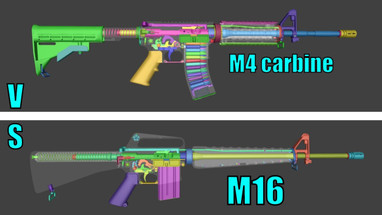Posted by Modulus Arms on 10th Sep 2021
AR15 vs M4 vs M16
Are you confused about what an AR-15 is and the difference between that versus an M4 or an M16? Don’t worry, everyone starts with zero level of firearms history knowledge and the confusion is understandable. Perhaps you’ve heard or previously seen others saying, “the M16 was a plastic toy,” while referring to the US rifle used in the Vietnam War as “the good old Mattel-16!” The mainstream media likes to call the AR15 a “weapon of war” which is incredibly misleading. Today we aim to clear some of that up so by the end of this blog you’ll be able to distinguish between AR15 vs M4 vs M16.
What’s the Difference Between the AR-15 and the M16?
The skinny — M16 was a government issued rifle with a 20 inch barrel and full auto, select fire capabilities. The AR-15 is the modern evolution and civilian version of what was originally developed from the M16 which millions of Americans own today as it is the most popular sporting rifle in the country.
To help you understand some of these rifles’ background more, a brief breakdown of the original models’ timeline looks like this: The original Armalite-15 rifle was designed in 1956 and produced until the updated version for the military was manufactured beginning in 1964.
What does the ‘M’ stand for in M16?
A common misconception is that people will mistake the ‘M’ in M16 as a designation that stands for the military but that is incorrect. While the ‘M’ in M60 stands for ‘machine-gun’ the ‘M’ in M16 stands for ‘model’ as it was the 16th model to be designed by Armalite.
Why did the M4 replace the M16?

As the US began deploying and fighting in more urban environments the need for a shorter and more compact, wieldy rifle was needed. Enter the M4. The M4 rifle began life as the “XM177” manufactured by Colt as an attempt to adapt the M16 design into a more compact weapons platform, or a “carbine”. The difference between carbine and rifle specs being primarily size, length and weight. So a carbine is essentially a smaller version of a “full-sized” rifle.
The barrel was cut down to 14.5 inches, the upper receiver was given a picatinny rail, it used 30 round mags as standard capacity and was manufactured with much higher pressure tolerances to accommodate for the more modern variants of the 5.56 NATO cartridge, such as the M855, M856, and later on the M855A1.
This gun has been in use by the United States Military since 1991, and like the M16, it has seen several different variations/modernizations over the years. The main takeaway in differentiating the M16 vs M4 is the M4’s higher pressure tolerances, shorter barrel, and greatly improved handling due to its overall size and length. Unfortunately for us civilians, we can’t own these full automatic, select fire rifles as they are machine guns manufactured after 1986.
Can you legally own an M16?
Citizens that reside in states that allow for the ownership and possession of NFA items such as machine guns can legally own firearms such as the M16. But is there a point to owning an M16 over an AR-15? For most people, the answer is no. M16s are incredibly expensive and can cost up to five figures. They also require extensive paperwork, the NFA tax stamp and additional fees (because as we all know the government needs its cut too).
For a vast majority of Americans, AR-15 is the much more sensible option, with its widespread availability, an extremely large aftermarket for upgrades and aesthetic changes. Assuming you live in a free state, to avoid paying tens of thousands of dollars you could always buy furniture to emulate the M16 look if that’s the look you’re going for.
Modern AR15s

The AR-15 has evolved into the most popular semi-automatic civilian rifle in American history. You’ll typically see AR-15s with a 16” barrel and mil-spec parts such as standard A2 pistol grip, and a “birdcage” flash hider. They’re also fairly light, with stock models weighing in at around 6.5 pounds. They’ve become an extraordinarily modular platform thanks to the wealth of aftermarket parts and support, a far fetch from its more roots.
AR15 vs M16 Origins
Very quickly into the US campaign during the Vietnam War, soldiers were reporting that they were getting out-gunned by the Viet Cong’s AKMs, and that the standard issued M-14 simply couldn’t keep up with the volume of accurate fire that an AK could dish out in close to medium distance engagements. Eugene Stoner, who had previously submitted his AR-10 rifle design to the US military for testing, was asked to rework his rifle design to fire a smaller, more controllable and effective cartridge.
Stoner did just that, and that’s how the original AR-15, then given the official military designation of “M16”, was born. The M16 was defined by its 20” barrel, integrated carry handle and plastic handguard for weight savings. It also fired the .223 Remington cartridge, specifically designed as a frangible intermediate rifle cartridge as opposed to the M14’s much larger (7.62x51mm NATO) .308 Winchester. It was also given a forward assist at the request of the US Army.
Since then, there have been many variants of the M16 spanning from the initial improvement of the original M16 to the M16A1 and the most recent iteration; the M16A4. The differences are mostly modernizations such as picatinny rails and higher pressure tolerances for the new 5.56x45 NATO round. That being said, despite the military using the Armalite platform for over half a century, the M16 was not initially well-received.
What Was Wrong With the M16?

The original M16 was wrought with issues, however, most of them had nothing to do with the design of the platform itself: It was mainly meddling from the US government that caused the multitudes of issues that the M16 faced. Initially, the M16 was designed to use a specific kind of gun powder called ‘extruded powder’ but was replaced with ‘ball powder’ because ball powder burns faster which offers higher velocity (a good thing for terminal ballistics).
In addition to cycling issues, the ball powder caused much more fouling, which is residue left in a gun’s internal parts after firing black powder. This meant the gun had to be cleaned more often to ensure proper performance which contradicted what soldiers were instructed. When being issued the original rifle, soldiers were told the M16 cleaned itself when firing. Eventually, these mechanical issues were resolved through the advent of chrome plating and chambering the bore — but it left a stain in the minds of the soldiers who were among the first to be issued the rifle.
What is an AR16?
Let’s quickly get this question out of the way: What is an AR16? To put it simply, this term doesn’t exist and is a misnomer/combination of Eugene Stoner’s invention of the AR-15 rifle and the military version of the same rifle, the “M16”. People using the term “AR-16” are likely not knowledgeable about firearms, well-meaning or not. So if you ever hear someone say “AR16” they probably mean AR15.
Start your next AR15 build with Modulus Arms!
Whether you want your rifle to look like the venerable M16 which traversed jungles and deserts alike or the M4 which saw combat in the Middle East, you can start that build with our 80% lower receiver. Don’t forget the Router Jig Extreme™ too so you can mill out any 80 percent lower receiver you purchase to machine them into fully functioning firearm components.

